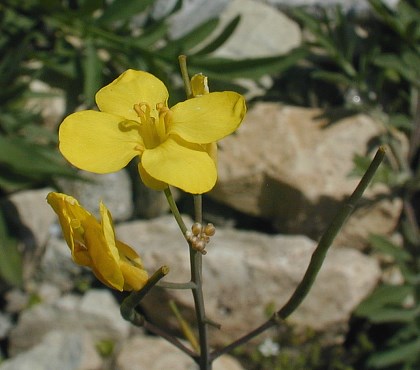Annuals or biennials; (roots fleshy or slender); (green to slightly glaucous), glabrous or sparsely hairy. Stems unbranched or branched distally, 3-10 dm. Basal leaves: petiole (winged), (1-)2-10(-17) cm; blade ± lyrate-pinnatifid to pinnate to pinnatisect, (5-)10-40(-60) cm × 30-100(-200) mm, (margins sinuate-dentate, sometimes ciliate), lobes 2-4(-6) each side, (terminal lobe oblong-obovate, obtuse, large, blade surfaces usually setose). Cauline leaves (middle and distal) sessile; base auriculate to amplexicaul, (margins subentire). Racemes not paniculately branched, (with open flowers overtopping or equal to buds). Fruiting pedicels ascending to spreading, (5-)10-25(-30) mm. Flowers: sepals (3-)4-6.5(-8) × 1.5-2 mm; petals deep yellow to yellow, obovate, 6-11(-13) × (2.5-)3-6(-7) mm, claw 3-7 mm, apex rounded; filaments 4-6(-7) mm; anthers 1.5-2 mm. Fruits ascending to somewhat spreading, torulose, terete, (2-)3-8(-11) cm × 2-4(-5) mm; valvular segment with 8-15 seeds per locule, (1.3-)2-5(-7.5) cm, terminal segment seedless, 8-22 mm. Seeds black, brown, or reddish, 1.1-2 mm diam.; seed coat very finely reticulate-lightly alveolate, not mucilaginous when wetted. 2n = 20.
Flowering Apr-Sep. Roadsides, disturbed areas and waste places, cultivated fields, grain fields, orchards, gardens; 0-1500 m; introduced; Alta., B.C., Man., N.B., Nfld. and Labr., N.W.T., N.S., Ont., P.E.I., Que., Sask., Yukon; Ala., Alaska, Ariz., Ark., Calif., Colo., Conn., Del., D.C., Fla., Ga., Idaho, Ill., Ind., Iowa, Kans., Ky., La., Maine, Md., Mass., Mich., Minn., Miss., Mo., Mont., Nebr., Nev., N.H., N.J., N.Mex., N.Y., N.C., N.Dak., Ohio, Okla., Oreg., Pa., R.I., S.C., S.Dak., Tenn., Tex., Utah, Vt., Va., Wash., W.Va., Wis., Wyo.; Europe; Asia; Africa; introduced also in Mexico, West Indies, Central America, South America, Atlantic Islands, Australia.
Brassica rapa is widely cultivated as an oil crop and vegetable, and cultivars, especially in Asia, have been recognized as species, subspecies, and varieties. The most important crops include: rapeseed or canola, turnip (subsp. rapa), Chinese mustard or pakchoi [subsp. chinensis (Linnaeus) Hanelt], and Chinese cabbage or petsai [subsp. pekinensis (Loureiro) Hanelt]. The species is also a widespread naturalized weed [subsp. sylvestris (Linnaeus) Janchen] throughout temperate North America and elsewhere. It is self-incompatible. Hybridization in the field in Europe has been described between B. napus and B. rapa (R. B. Jørgensen and B. Andersen 1994).
Annual herb to 0.8 m tall
Flowers: in branched clusters, stalks widely spaced, yellow, 1 cm wide. Petals four. Stamens six.
Fruit: a narrow pod, usually ascending, 3 - 5 cm long, roundish in cross-section, with an 8 - 15 mm long beak. Seeds 1.5 - 2 mm long.
Lower leaves: alternate, stalked, basically pinnately lobed, bristly along the margins, with a waxy coating (glaucous).
Upper leaves: alternate, stalkless, clasping, smaller than lower leaves, lance-shaped to oblong, sometimes toothed, with a waxy coating (glaucous).
Similar species: Brassica rapa and B. napus are the only two Brassica species in the Chicago Region with at least the middle and upper leaves clasping. Brassica napus is otherwise similar, but it is not covered with a waxy coating (glaucous).
Flowering: late May to early October
Habitat and ecology: Introduced from Eurasia. Occasional in recently cultivated fields, waste ground, and railroad ballast.
Occurence in the Chicago region: non-native
Notes: The name Brassica rapa also refers to a number of cultivated vegetables that were derived from it, including the turnip.
Etymology: Brassica is the Latin word for cabbage. Rapa means turnip.
Author: The Morton Arboretum
Duration: Annual
Nativity: Non-Native
Lifeform: Forb/Herb
General: Herbaceous annuals or biennials, to 120 cm tall, stems unbranched or branched distally, herbage glabrous or sparsely hairy.
Leaves: Alternate, lower leaves petioled with lyrate-pinnatifid blades, 10-20 cm long, upper blades sessile, auriculate-clasping, margins dentate to subentire. Upper leaves glaucous and glabrous, the lower usually with scattered hairs.
Flowers: Yellow, showy, petals obovate to spatulate, 6-11 mm long, with a claw 3-7 mm long, this with a rounded apex, sepals 4-6.5 mm long, ascending or spreading, filaments 4-6 mm long, flowers borne in spreading, elongate racemes on pedicels 1-2 cm long.
Fruits: Elongate siliques 4-9 cm long, stout, swollen and constricted at intervals (torulose), conspicuously beaked, beaks conic, 10-20 mm long, silique dehiscent below but the beak is indehiscent. Seeds dark, to 2 mm thick, occurring in a single row, 8-15 per lo
Ecology: Found in disturbed areas, roadsides, cultivated fields, orchards, gardens, from 0-5,000 ft (0-1524 m); flowering April-September.
Distribution: Widespread across North America, native to Eurasia. Probably an escaped cultivar.
Ethnobotany: The roots were used as food, and the leaves were eaten as greens.
Synonyms: Numerous, see Tropicos
Editor: LCrumbacher 2011
Etymology: Brassica comes from a a Latin name for "cabbage", while rapa is an old Italian name for turnips.
Annual to 8 dm, green and sparsely setose-hispid, at least along the lf-margins and the midrib beneath; lower lvs petioled, pinnately ±lobed; upper lvs oblong to lanceolate, dentate or entire, sessile and clasping; fls 1 cm wide; mature pedicels widely ascending, 1-2 cm; frs ascending to suberect, terete or nearly so, 3-5 cm, the slender beak 8-15 mm; seeds 1.5-2 mm, minutely roughened; 2n=20.
B. rapa as here defined includes the field-weed (often called B. campestris L.) and a number of cultivars derived from it, notably turnip and bird's rape. The related sp. B. oleracea L., glabrous and glaucous, 2n=18, includes a host of cultivars (cabbage, cauliflower, broccoli, Brussels sprouts, etc.) derived from a wild European form that is often segregated as B. sylvestris (L.) Mill. Rape and rutabaga are referred to B. napus L. (2n=38), thought to be an alloploid of the other two spp. Infraspecific nomenclature here is tangled.
Gleason, Henry A. & Cronquist, Arthur J. 1991. Manual of vascular plants of northeastern United States and adjacent Canada. lxxv + 910 pp.
©The New York Botanical Garden. All rights reserved. Used by permission.
This weed has been reported twice for the state and I have specimens from two counties. Almost all crucifers are of a weedy nature. Peattie says it is established in the Calumet Region and I found it to be plentiful in the old Fair Grounds at Lawrenceburg, Dearborn County.













